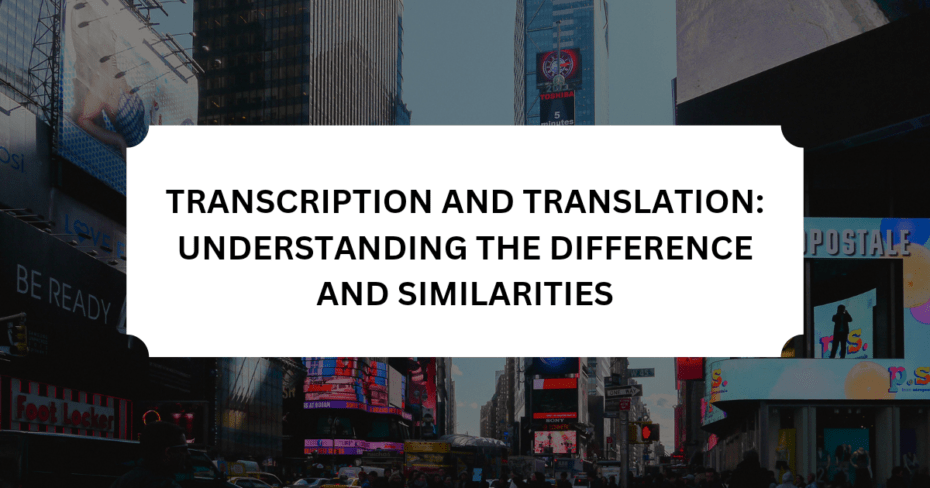Table of Contents
In the modern world, where global interactions are commonplace, transcription and translation have become more relevant than ever. Transcription and translation, while often used interchangeably, serve different yet equally crucial purposes.
The understanding of these processes, particularly in an online context, is invaluable in a wide array of sectors, ranging from academia and business to media and healthcare.
What is Transcription?
Transcription is a process that involves converting audio or video content into written text. This service, often employed in professional settings, plays an indispensable role in making information more accessible, manageable, and usable. While this process may seem simple on the surface, it involves several critical elements such as accuracy, consistency, and detail-orientation.
For instance, consider a recorded speech or an interview. Transcription would take that recorded content and transform it into a written document, verbatim or otherwise. It is particularly useful when there’s a need to analyze, store, or share the spoken content in text form.
For accessibility purposes, transcripts can provide a valuable means for individuals who are deaf or hard of hearing to access and understand the content. The convenience of having information at one’s fingertips, capable of being perused at any time, cannot be underestimated.
Different Types of Transcription Services Online
Online transcription services are diverse, accommodating a wide range of needs and content types. The most common ones include audio transcription and video transcription.
Audio transcription involves the conversion of audio files into written text. These could be anything from podcasts, interviews, dictations, conference calls, to lectures. Various industries like journalism, law, and academia frequently use this service for record-keeping, data analysis, and content creation.
Video transcription, on the other hand, pertains to transcribing both the auditory and visual elements of a video file. Besides spoken words, it may also include descriptions of non-verbal cues and on-screen activity. This is extremely useful in media production, online content creation, and digital marketing, where it’s essential to understand the complete context.
Benefits of Online Transcription Services
Online transcription services provide a multitude of benefits across various sectors. In academia, transcription services assist students and researchers by converting lectures, interviews, and seminars into text, making information easily searchable, and study materials more accessible.
In the legal sector, transcription is crucial for creating accurate records of court proceedings, testimonies, and legal communications. This not only helps in maintaining the integrity of legal processes but also aids in case analysis and review.
In the medical field, transcription of physicians’ notes, patient interactions, and medical seminars supports healthcare providers by facilitating clear communication, comprehensive documentation, and ultimately, better patient care.
In the business world, transcription of meetings, conferences, and training sessions provides written records that can be referenced for decision-making, strategizing, and training new employees.
Lastly, in the media and entertainment industry, transcribing content makes it more accessible and enjoyable for a wider audience, including those with hearing impairments. It also helps in SEO optimization of video content, contributing to increased visibility and engagement.
What is Translation?
Translation is a process that involves converting written or spoken content from one language to another. It is a critical tool for bridging language barriers, fostering mutual understanding, and facilitating global communication.
It is more than just a word-for-word substitution; it involves interpreting the meaning, context, tone, and cultural nuances of the original content, then reproducing them in the target language. This requires a deep understanding of both the source and target languages, as well as the subject matter.
Consider, for example, a business contract written in English that needs to be understood by a Japanese partner. A translator would take that contract and translate it into Japanese, preserving not just the legal jargon but also the intent, style, and tone.
By ensuring that the translated content mirrors the original as closely as possible, translation allows people of different linguistic backgrounds to communicate effectively and accurately.
Different Types of Translation Services Online
Online translation services have revolutionized the way we handle multilingual communication, offering a range of specialized services to meet diverse needs.
Document translation is one of the most common services. It involves translating written materials such as contracts, manuals, reports, books, and more. Each type of document may require specific knowledge in a particular field, such as legal, technical, or medical expertise.
Website translation, on the other hand, involves translating all the textual content of a website into another language. This includes not just the visible content, but also meta descriptions, alt tags, and other SEO-related elements. This service is vital for businesses looking to expand to global markets, as it allows them to communicate effectively with foreign customers in their native language.
There are also more specialized services like certified translation, which provides a certificate of accuracy for legal purposes, and software localization, which involves adapting software interfaces and functionalities to suit different languages and cultures.
Advantages of Online Translation Services
Online translation services play an integral role in numerous areas. In the global economy, they allow businesses to reach international markets, fostering understanding and trust with foreign customers by communicating in their own language. This can lead to increased sales, customer satisfaction, and brand loyalty.
In the field of communication, translation breaks down linguistic barriers, allowing people from different countries and cultures to share ideas, collaborate, and build relationships. This is essential in international diplomacy, multinational corporations, and even online platforms where users from around the world interact.
In the academic world, translation allows research and knowledge to be shared across different languages, enriching the global body of knowledge and promoting cross-cultural understanding.
Moreover, online translation services offer the advantage of speed, convenience, and accessibility. You can have your content translated from anywhere, anytime, without having to physically visit a translation agency or meet a translator.
The Similarities
Online transcription and translation services, while distinct in their function, share a number of commonalities. Firstly, both processes serve the core purpose of making content more accessible and usable. They take spoken or written information and transform it into a different format or language, thereby increasing its reach and utility.
Both services require a deep understanding of language and context. Whether it’s transcribing a medical seminar or translating a technical document, the service provider must comprehend the subject matter to accurately convey the intended meaning.
Additionally, online transcription and translation services both leverage technology to improve speed, accuracy, and efficiency. For instance, speech recognition technology is often used in transcription, while machine translation with human post-editing is common in translation.
Finally, both services are integral to numerous sectors such as business, academia, healthcare, law, and media, providing critical support in communication, documentation, and information dissemination.
The Differences
Despite these similarities, transcription and translation also have significant differences. The most fundamental distinction lies in their basic function: transcription involves converting speech into text, while translation involves converting content from one language to another.
The skills required for each process are also different. Transcription primarily requires excellent listening skills, fast and accurate typing, and a good grasp of the language and subject matter. Translation, on the other hand, requires fluency in both the source and target languages, cultural knowledge, and expertise in the topic being translated.
Furthermore, the challenges each process presents are distinct. In transcription, challenges may include dealing with poor audio quality, multiple speakers, or fast speech rate. In translation, difficulties may arise from cultural nuances, idioms, or complex technical terms.
Transcription and Translation Combined
There are situations where transcription and translation are needed together. This is typically in the case of multilingual content that needs to be transcribed and then translated. For instance, an international conference with speakers of different languages might need the speeches to be transcribed in the original language and then translated into other languages.
Another common scenario is in the production of subtitles for foreign films or videos. The spoken dialogue is transcribed, time-coded, and then translated into the desired language, making the content accessible to foreign audiences.
Similarly, in the field of market research, global companies may conduct surveys or interviews in different countries. The responses would need to be transcribed and then translated for analysis.
In these cases, the combined use of transcription and translation services ensures that the content is accurately captured, translated, and made accessible to the intended audience, regardless of their language or location.
Choosing the Right Online Transcription and Translation Service
When choosing an online transcription or translation service, there are several key factors to consider. Firstly, the accuracy of the service is paramount. Inaccurate transcription or translation can lead to misunderstandings, miscommunication, or even legal issues. Therefore, it’s essential to choose a service known for its high-quality output.
Cost is another important consideration. While pricing varies widely depending on the complexity of the project, the speed of delivery, and the level of expertise required, it’s crucial to find a service that offers good value for money. Remember, the cheapest option may not always be the best in terms of quality.
Turnaround time is a critical factor, especially when working under tight deadlines. Ensure the service can deliver within your required timeframe without compromising on the quality of the work.
Confidentiality is a crucial aspect, especially when dealing with sensitive information. The service provider should have robust security measures in place and a clear confidentiality policy.
Finally, consider the customer service of the provider. The ability to communicate with them easily, get questions answered promptly, and receive support throughout the process contributes significantly to a smooth and positive experience.
Trusted Service Providers
When it comes to reliable online transcription and translation service providers, a few names stand out due to their track record for quality, accuracy, and customer satisfaction.
In the world of transcription, services like Rev and GoTranscript offer fast turnaround times, high accuracy rates, and competitive pricing. They cater to a variety of sectors, including academia, law, and business, providing both general and specialized transcription services.
For translation services, companies such as Gengo and Straker Translations are well-regarded. They offer a wide range of services, including document translation, website translation, and certified translations. Their professional translators are experts in various fields, ensuring high-quality translations that consider cultural nuances and specific industry jargon.
Remember, choosing the right service provider is about finding the one that best aligns with your specific needs. Do your research, read reviews, and don’t hesitate to ask questions to ensure you’re making the right decision. The optimal transcription and translation services can enhance your communication, broaden your reach, and contribute to your success in the global arena.
Conclusion
In our interconnected world, the importance of understanding and appropriately utilizing transcription and translation services cannot be overstated. These services serve as critical bridges, converting spoken words into written text, transforming content across languages, and ultimately making information more accessible, usable, and shareable.
Transcription and translation, though distinct processes, share the common goal of facilitating communication. Transcription transforms audio or video content into text, making it easier to digest, analyze, and reference. This becomes invaluable in fields like academia, law, healthcare, and business where comprehensive and accurate documentation is essential.
On the other hand, translation breaks down language barriers, allowing the seamless flow of ideas, information, and values across cultures and borders. This plays a crucial role in global business expansion, cross-cultural understanding, and international relations.
When transcription and translation come together, they ensure the accurate capture and translation of content, making it accessible to a wider audience, regardless of their linguistic backgrounds or geographical locations.
Choosing the right online transcription and translation service is a decision that should be made carefully. Factors such as accuracy, cost, turnaround time, confidentiality, and customer service are essential considerations in this selection process.






